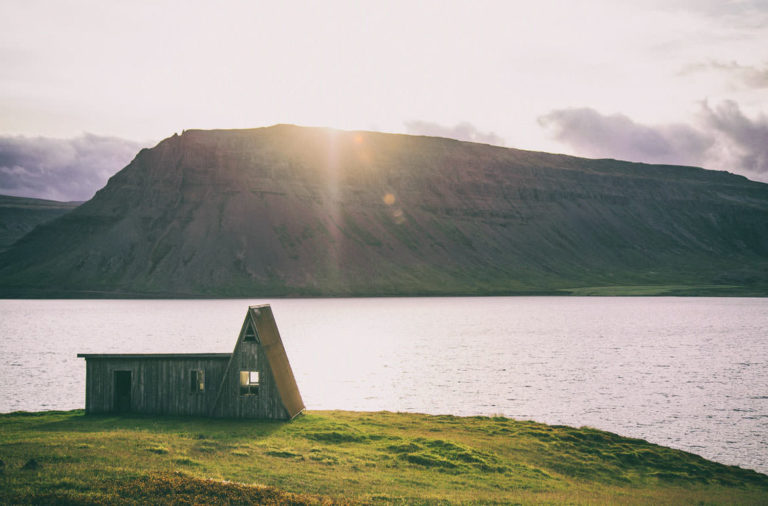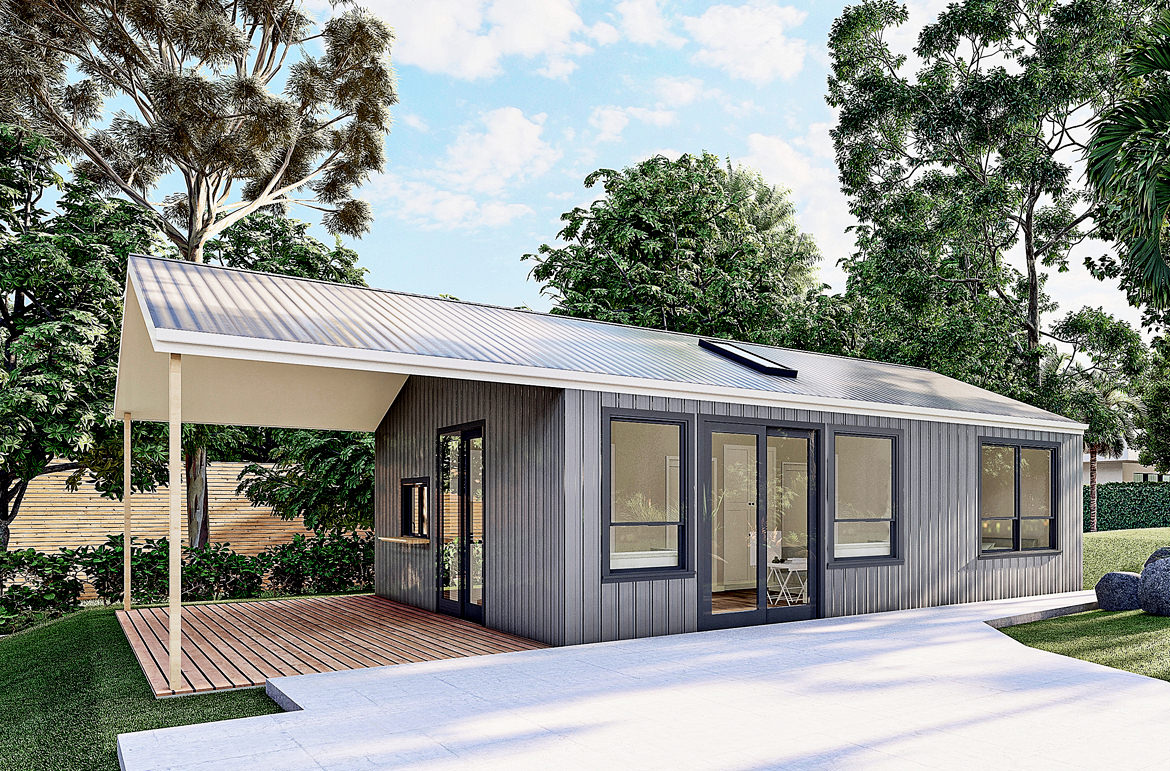
Looking at a shed, it seems logical to think about converting it into a habitable space.
So, can you convert a shed into a granny flat?
Short answer – yes. But, simply put, the shed/granny flat must meet specific regulations:
DON'T PAY A FORTUNE FOR YOUR GRANNY FLAT. Find out how to deal with council and build a granny flat for the lowest cost possible. Learn More.
- Your property is 450sqm or more (for most Councils – read more below)
- You stick to the ‘one property, one granny flat’ rule.
- Your land is residentially zoned.
- Your shed is under 60sqm in NSW and can be higher for some parts of QLD and WA, and is located:
- More than 3m away from any trees and your rear property line.
- More than 0.9m from your side boundaries.
- OR, IF NOT, you may be able to have a fire-rated wall for the wall which is closest to your boundary.
- Your living area and bedroom/s are 2.4m or higher, measured from inside.
Converting a shed into a granny flat may be more of an inexpensive choice – it’s an existing building, with four walls, roofing, a durable floor and stable foundation.
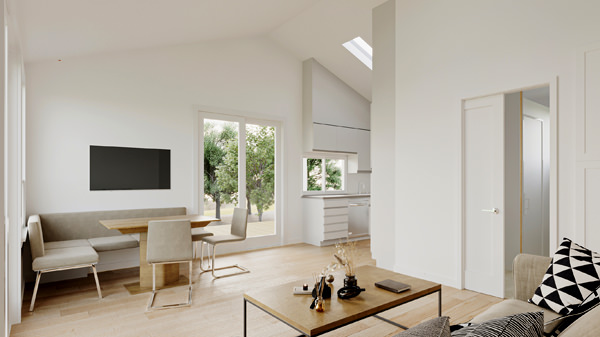
An internal conversion for one of our clients on the Central Coast of NSW
Read on to find out how to do this conversion.
Should I Buy a Shed and Convert it Into a Granny Flat Later On?
If you don’t already have a shed, you can purchase one and you may be able to convert it later.
There are many reasons to do this:
- You want to build quicker – This will reduce the time it takes to build substantially, as you can order a shed for delivery in just days, rather than the months it would take you to build something new.
- It can be less expensive – Shed manufacturers can buy their materials at wholesale prices. So you should be able to buy a shed for a lesser price than what it would cost you to make the frame yourself.
- Your shed may be better quality – The truth is, unless you’re well-experienced in construction, a shed built by an expert is probably going to be better quality. Also, a shed you buy should come with a warranty or guarantee, which may save you even more money in future.
- If you want time to gather money – Buying a shed can give you time to save money before building, or get a loan. If finding it difficult to get finance, your bank may be more likely to fund you purchasing a shed, or you may even be able to get financing directly from the builder of the shed itself.
- If you need time before building – It can give you time to, for example, work on improving your building skills.
Things to consider, which are the downfalls to purchasing in advance, are:
- You’ll have less input into design – Sheds are normally mass-produced. If personalising your granny flat is of high importance, then purchasing a shed may not be ideal, as you’ll have much less say into its’ look. You’ll also have to design the interior layout around the shed you purchased. It’s still worth looking at what sheds are out there to see if you can find one that suits you, but if you have a certain layout or style you want, an off-the-shelf design may not work.
- There are regulations to meet – You must meet the regulations of your local Council to receive approval. Especially important to think about will be the size of your shed, and the alterations that must be made to change it from what is currently an uninhabitable building, to a livable one.
- You will most likely need a floor plan – As you will have to add a bedroom, bathroom, living area, kitchen/kitchenette, windows, remove the wide doors to replace them with something more homely, and likely require stable partitions.
Don’t be put off though – we’ll get into the cost of conversion soon.
Are All Sheds Created Equally for Conversion Later On?
Simply put – no.
This is something to consider prior to purchasing a shed.
A big factor to think about is what sort of steel you want. Not all steel is created equally, and it’s important to recognise the difference between steel made in Australia, such as Colorbond, and imported steel.
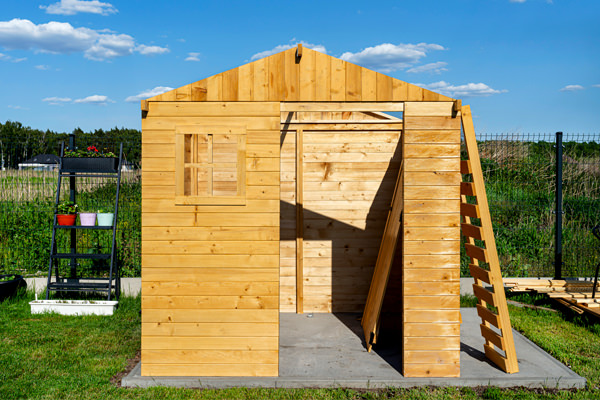
Not all sheds are build to meet the NCC (National Construction Code) so this needs to be rectified.
Australian steel has been made for our conditions, tested and proved dependable for years. These products have undertaken vigorous tests, both in the factory and in the field, to ensure they can stand-up against our extreme temperatures, corrosions, hails, winds, and more.
Imported steel can be more risky. You have a higher chance of it corroding, its’ colour fading, or it warping, earlier on.
Also, be wary – some suppliers may use imported steel to manufacture their sheds in Australia, but advertise them as “Australian-made”. Check by asking them where the steel come from. As this is the exoskeleton of your granny flat.
Another thing to think about is the conversion you have in mind – what you will be putting in the shed. Considering this will also be a massive help in figuring out what features you require in a shed.
How Much do Sheds Cost and What Is the Cost to Convert it Into a Granny Flat?
Prices of sheds vary. Custom-built sheds are usually more expensive than those you have to put together yourself. Timber the most expensive, while steel the least.
But starting at $12,000+ for a 6m x 10m shed (60m2, the maximum floor size allowable for a granny flat), you can get a steel shed that comes with a lifetime warranty, is fire resistant and waterproof, and maybe even have a warranty for being rust-resistant.
Onto costs for conversion. Prices depend upon the sheds size, and how many alterations it requires to be liveable. Put simply though, the larger your shed, and the more complicated your design, the more expensive the conversion could be
Let’s begin with approval fees:
- Surveyors Report – When building, I paid $1500. You, however, may not need this – it will depend upon your Council.
- A designer, and your BASIX Certificate– This can range widely, but a designer plays a major role when converting. You may notice that they will charge more per square metre. For an architect, budget for up to $2000 or more. But you can find a draftsperson for much less.
- Engineers Report – Budget for up to $2000.
- Final Approval (your Occupation Certificate) – You may be charged another $1800+ to have your certifier come and hand you this.
So, approval can cost as much as $7000+. As there are a few other reports and requirements that are needed for a successful approval.
You also need to discuss this conversion with either your local Council or a private certifier. You will often require a Development Application approved.
Now, costs for conversion itself. These are similar to what it costs to convert your garage, but sheds are normally much bigger in height than garages, so it will cost extra to make the conversion. We have gone over these below:
- Ventilation – If installing a kitchen or bathroom, you’ll need to make sure that there are adequate ventilation fans. You may also want to put in an air-conditioner. This can cost $1200 – $2000.
- Waterproofing – As well as ventilation, your bathroom must be tiled, fitted, waterproofed, checked for leaks and certified by an accredited Waterproofer.
- New Windows and Doors – Many sheds have either wide, or two doors. You may need to replace them with a smaller door, so it’s easier for you to enter and exit. Some sheds also don’t have windows, so you’ll need one or two installed, to have natural light and ventilation. There are tools that can cut through steel very nicely, but if you don’t have the skills for this, it’s best you hire a professional. These charges can vary greatly – windows alone can cost between $150 to $2000 each, and installation $40 to $50 per hour.
- Insulation – Sheds do not come with insulation, so insulating the walls and ceiling ensures your granny flat stays cooler in summer and warmer in winter. This also limits the chance of rust and reduces the noise of hail or rain on your steel roof. Insulation panels can be purchased from your local hardware store, and you can look at paying roughly $338 – $1000+ in total.
- Plumbing & Sewerage – As you’ll need a bathroom, you’ll require professional assistance. A plumber and drain lines will cost roughly $1,000 to $1,500+.
- Electrical Work – A permanent source of power will be required. You’ll most probably need an electrician to install these fixtures, who charge around $50 to $100 per hour. The electrical products will cost around $150 as a starting point.
- Cupboards – You’ll need places for storage, such as cabinetry. Less expensive stock cabinets will cost a minimum of $1500 for a little kitchen alone.
- Wood Framing the Walls – Your shed is normally made from a steel frame. You could leave it as is, but will be able to see the insulation. Instead, put wood framing, plasterboard or drywall on the inside, to create a more traditional looking interior. This lets you have the benefits of steel on the exterior, but wood inside where you are not as likely to require steels durability. Expect to pay more than $2000, which includes installation.
- Paint – No need to spend your entire savings on paint. $500 is a rough estimate.
- Flooring – You can put any flooring of your choice over the building’s foundation. These prices can range greatly depending on the product, but a good one to consider is vinyl flooring, which is waterproof, looks like wood but is gentler on your feet, available at most home improvement stores, and an affordable $34.90+/m2.
- Fixtures and Devices – This includes everything from toilet/s, sinks, the oven, and lights. A low-balled estimate is $1800, but you could spend far more on lush products.
- Landscaping – Landscaping is essential, as it ensures privacy for those in the main home, and those in the granny flat. You’ll pay up to $3000 for a professional.
- Parking – Your local Council has the final say on whether you need an extra car space for your granny flat or not. If so, you may need a concreter to quote you for a driveway.
Are the Foundations of Sheds Different to Granny Flats?
Unfortunately – no. I’ll go into the difference between a Class 10a building and and Class 1a building under the next sub-heading, but this is a big one.
Many sheds are built on a standard concrete slab. This is okay to park a car in, but because they aren’t lined with a vapour barrier in many cases, as time passes the slab retains more and more water leading to rising damp, which can be a huge problem. There needs to be an engineering solution to this common problem.
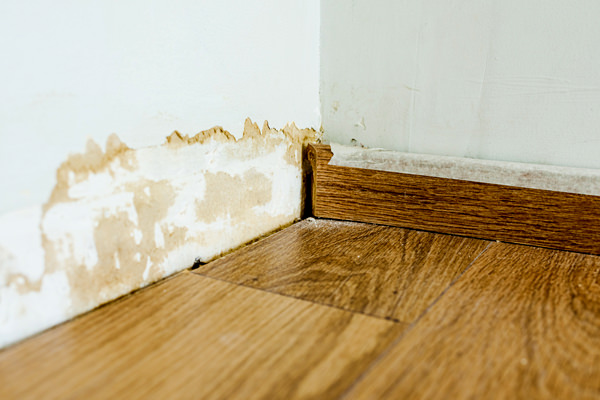
A damp floor in a poor-conversion causes all types of problems later on.
Your granny flat foundation cannot have any settlement, as this can result in the internal linings of the walls to break out in large cracks. So your granny flat must have a much stronger slab or be built on piers.
Can You Live in a Shed?
Is it possible to live in your shed?… Well, maybe. Generally speaking, living in your normal shed is not possible, as it is a Class 10a building, and these are uninhabitable.
To make living in a shed possible, it must be classified as a Class 1a building.
Every Council will have its’ own regulations on what makes it a Class 1a, but some of your typical specifications include that:
- The design of its’ foundation conforms to the criteria of the Building Codes of Australia.
- It has sanitary provisions (a shower, toilet, and sink) that are secured to either sewerage or an on-site waste management system.
- It’s connected to either town or tank water.
- It has a smoke alarm.
- You can cook in the kitchen.
- There’s enough room for a washing machine, and
- It complies with the bushfire and flood regulations for your zone.
I advise you to contact your local Council, as they can give you a full list of the construction standards for your location.
Conclusion
If you have a shed in your backyard not being used, you can convert this into a granny flat, fairly inexpensively. Or, you can buy a new shed, and do the same. See “Can You Build Your Own Granny Flat?” for information on how to get your “owner-builder” license, before beginning.




